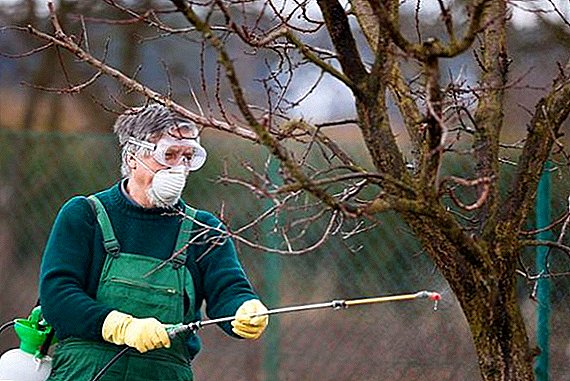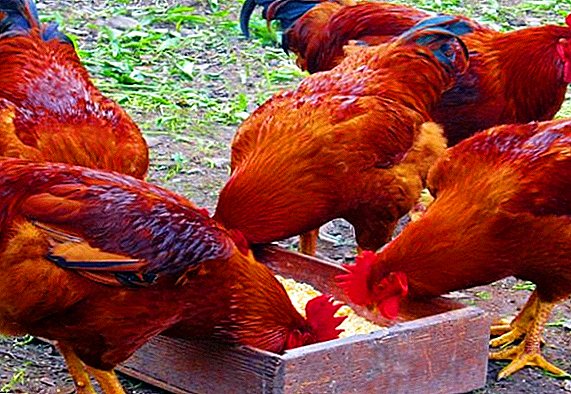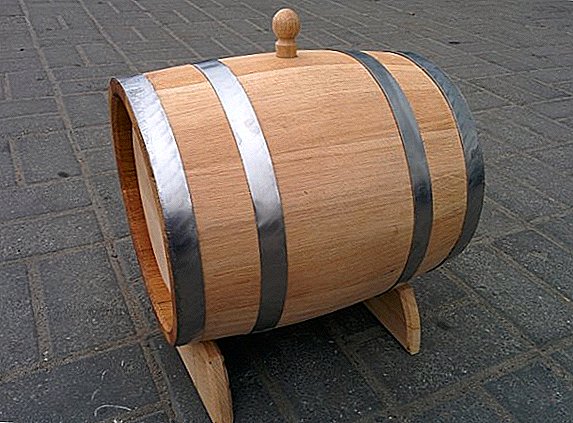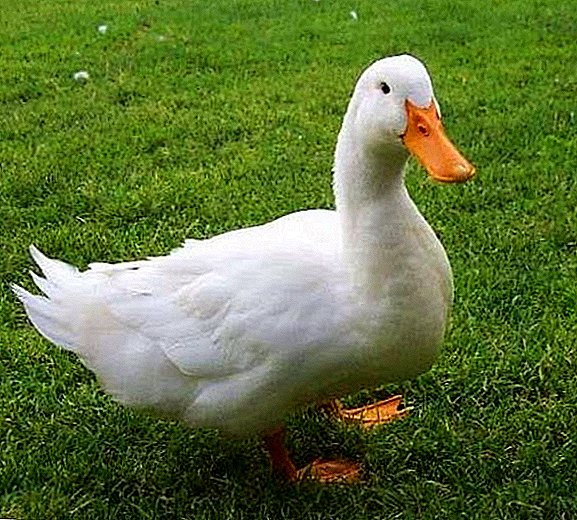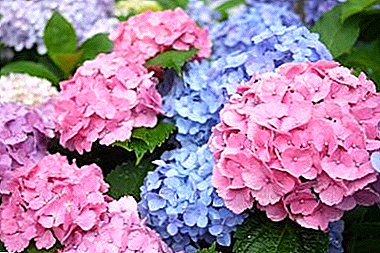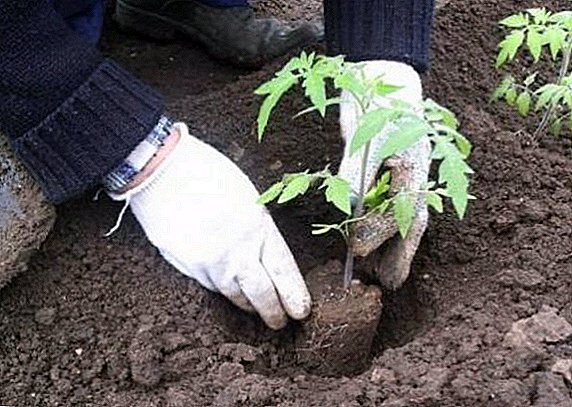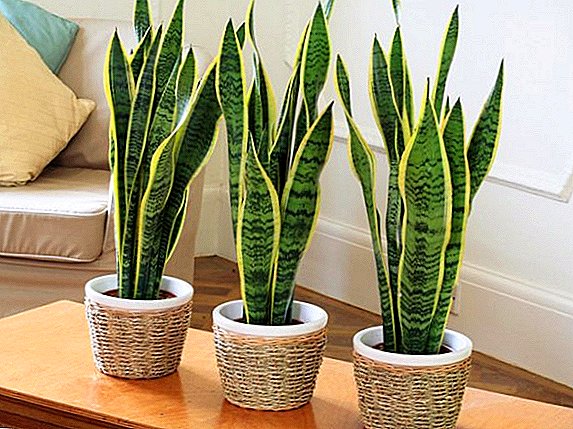 Sansevieria, or sanseviera - it is a stemless herbaceous evergreen perennial succulent belonging to the Asparagus family. It grows in savannas and subtropics of Africa, America and Asia. There are about 60 species of this plant. As a indoor flower is appreciated for unpretentiousness. Due to its appearance it is often used in interior design.
Sansevieria, or sanseviera - it is a stemless herbaceous evergreen perennial succulent belonging to the Asparagus family. It grows in savannas and subtropics of Africa, America and Asia. There are about 60 species of this plant. As a indoor flower is appreciated for unpretentiousness. Due to its appearance it is often used in interior design.
Did you know? Because of its striped, stiff and long leaves, sansevieria is often called the "pike tail". Also known as "snake skin" or "mother tongue". In Japan, it is called the "tail of the tiger," and in Turkey it is called the "pasha sword."
Ideal conditions for growing Sansevieria
 This plant is suitable for growing not only beginner growers, but even those who have not survived any representative of the flora, because it leads in all sorts of endurance ratings. Yet sanseviera has its own needs, and before planting it is worth getting acquainted with the peculiarities of its agricultural cultivation.
This plant is suitable for growing not only beginner growers, but even those who have not survived any representative of the flora, because it leads in all sorts of endurance ratings. Yet sanseviera has its own needs, and before planting it is worth getting acquainted with the peculiarities of its agricultural cultivation.
Location and lighting
Since Sansevieria’s birthplace is rich in sunlight, it’s better to provide bright light, fit a place on any window sill of your house. The south-west or south-east side is best.
The brightest varieties require the most abundant illumination, and in deep shadow the color of the leaves will fade, become almost monotonous, and growth will stop. Of course, the plant will not die from insufficient light, but it will develop worse.
Staying on a hot southern window will not destroy the indoor flowers of sansevieria either, only in the most sunny hours burns are possible, shading will become necessary.
Important! If you do not want the plant to grow at an angle, you need to rotate it regularly.
Air temperature and humidity
 The temperature in the summer will suit any, even +30 ° C will not cause sansevieri harm. In winter, it is able to endure short periods of fall to +5 ° C, but it is still better that the temperature does not fall below +16 ° C, so that the roots do not rot.
The temperature in the summer will suit any, even +30 ° C will not cause sansevieri harm. In winter, it is able to endure short periods of fall to +5 ° C, but it is still better that the temperature does not fall below +16 ° C, so that the roots do not rot.
Rather than dry air, spraying is not required, especially at low content temperatures. But from time to time you should wipe the leaves with a damp sponge from dust.
How to care for evergreen shrubs
Caring for sansevieriya at home is minimal, just follow the basic rules, and the plant will feel great.
Did you know? The spines of sansevieria possess elasticity and hardness, therefore, they used to be used as needles for a gramophone before. And in areas of Central Africa, this plant has also been used to make strong ropes and coarse fabrics.
What mode of watering loves "pike tail"
Ponytail - This is a drought-resistant plant, and it is not recommended to flood it. Watering sansevierii should be regular, but moderate.
 In spring and summer - once every 5-7 days (less often in cloudy weather), immediately after the soil has dried.
In spring and summer - once every 5-7 days (less often in cloudy weather), immediately after the soil has dried.
In winter - 1-2 times a month, a day after the soil dries. Water is suitable rainwater, distilled or separated at room temperature.
Ensure that watering is not excessive (especially in cold conditions), and the liquid does not get into the outlet itself. After all, these are the reasons why sansevieria leaves and leaves become soft and sluggish, why they turn yellow and rot at the base.
How often and how to do feeding
In winter, this unpretentious plant does not need fertilizer at all, and from late spring to early autumn, fertilizing can be done 1 time in 2 - 4 weeks. To do this, use fertilizers for cacti and succulents or conventional mineral fertilizers.
Important! For varieties with decorative colored stripes, the dosage (especially nitrogen-containing fertilizers) is tripled. Otherwise, excess chlorophyll production will make the leaves monotonously green.
Pruning Sansevieria
Trimming procedure Sansevieri is very simple. By observing the principle of moderation, because excessive pruning can stop the growth of a plant, remove old, badly damaged leaves that have lost their decorative effect, as well as yellowed and rotted parts. Do not cut the tips of the leaves.
Transplanting and soil selection
 Transplantation of Sansevieria is best done in spring or early summer. She has good growth rates, so young specimens are transplanted every 2 years, mature - 3.
Transplantation of Sansevieria is best done in spring or early summer. She has good growth rates, so young specimens are transplanted every 2 years, mature - 3.
The signal for you will be the roots protruding from the pot. Choose a new thick-walled pot, heavy, preferably wide and shallow, as this plant has a strong surface root system. Must be a good layer of drainage (suitable pebbles, expanded clay).
If you have just purchased a home flower of the sansevieri, then the earthy bed should be completely removed, because the store soils are usually too saturated with peat and depleted. Next, inspect the roots for damage or rotting.
Place the soil on top of the drainage layer (at least 1/3 of the capacity). Light, fast-drying and low-nutritional food will do. You can use special earth mixtures for cacti and succulents, or mix in equal proportions sand, turf and leaf land.
Now you can plant a piketail. Slightly press down the roots and pour plenty of water. After transplantation, tall plants should be tied up to a support, because powerful leaves can outweigh, and sansevera will fall out of the pot.
How to propagate the sansevieru at home
 Reproduction is possible by dividing the rhizome, leaf or side shoots, as well as seeds.
Reproduction is possible by dividing the rhizome, leaf or side shoots, as well as seeds.
When dividing rhizomes it is cut with a sharp knife so that each part has its own point of growth. Each piece is planted in a separate pot and put in heat, ensuring moderate watering.
When dividing the sheet it should be divided into parts of 4-5 cm long, hold them briefly in air and place the lower end of each in the sand (at an angle of 45 °). Next, you need to cover each piece with a bottle or jar and place in a warm and bright place without direct sunlight.
When watering water is poured into the pan. After 30-40 days, as soon as it turned out to root out sansevieria and buds appeared, it can be transplanted into a container with soil. This method is not suitable for variegated species, since with this method of propagation they lose decorative stripes and grow monotonous.
 You can also separate the process from the main stem and place it in water. In about a month, the roots will form, and the seedling can be planted in the ground.
You can also separate the process from the main stem and place it in water. In about a month, the roots will form, and the seedling can be planted in the ground.
If at the end of flowering you have seen on the ground near the plant shoots similar to dill, then you can collect seeds and sow them in the ground. Powder is not necessary. Shoots will appear in 10-15 days. You can dive in 1 month.
Possible problems and pests sanseviery
You are unlikely to have serious problems with the sanseviera, but some troubles, often due to incorrect care, are possible.
If there are dark spots on the leavesthen most likely you overdo it with watering at low temperature.
With yellow leaves most likely lack of lighting or too small pot.
If the tips wither, dry and turn yellow, then there may be a lack of light, and excessive watering, and too low content temperatures.
The leaves are soft and bend in half - more likely that they stretched out in search of light and do not maintain their own weight.
 Why have pike tail leaves curled? Maybe you forget to water it for a long period of time.
Why have pike tail leaves curled? Maybe you forget to water it for a long period of time.
Sansevière may become a pale yellow color, and on the leaves with white spots appear. All are symptoms spider mite infection.
To get rid of it, you must constantly wipe the leaves with a damp sponge or process a special insecticide. As a preventive measure, moisten the air regularly.
To combat thripsthat manifest themselves in the form of bright spots on the leaves and an abundance of larvae on the opposite side, it is necessary to treat the plant with insecticides several times.
If the leaves turn yellow and twist, like flower stalksthen probably mealybore damage. Clean the pest manually and wipe the sheets with a damp cloth.. It is also possible to use insecticides (with a strong lesion).
Application and useful properties
"Shchuchy tail" is rich in biologically active substances. The most important for modern medicine are saponins.
They are used in the production of laxative, anti-inflammatory, choleretic, and expectorant drugs.
Saponins have foaming properties and are therefore used in the manufacture of shampoos and liquid soaps.

In folk medicine, sansevieru is used to treat cystitis, otitis, oral inflammation, cuts and other injuries of the skin.
Not recommended during pregnancyas the plant contains substances possessing abortive action.
Did you know? Sansevera enrolled in a list of plants (compiled by NASA) that can absorb nitric oxide and formaldehyde.
Sansevieria is an almost indestructible plant that does not die and does not wither even without leaving it for 1-2 weeks. In addition, it has an attractive appearance and a lot of useful qualities.


